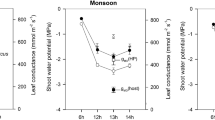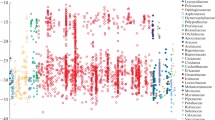Summary
Xylem-tapping mistletoe species growing on Mimosaccae, non-Mimosaceae and hosts performing Crassulacean acid metabolism (CAM) were studied along an aridity gradient in the Namib desert. °13C-values of mistletoes became more negative with decreasing nitrogen (N)-concentration in their leaves, while the host plants showed no such relationship. This might suggest that mistletoes regulate their water use efficiency according to the nitrogen supply from the host. However, further inspection of the data indicates that the relations of δ13C-values with leaf nitrogen in mistletoes may result from carbon input from the host. This is especially true for mistletoes growing on CAM plants which exhibit a very high δ13C-value, but show no evidence of CAM. It is calculated that about 60% of the carbon in mistletoes growing on C3 and on CAM hosts originated from the host. The hypothesis of Marshall and Ehleringer (1990) that xylem tapping mistletoes are also carbon parasites could explain the change in δ13C-values with N-supply and the difference in δ13C-values between mistletoes growing on C3 and CAM hosts.
Similar content being viewed by others
References
Ehleringer JR, Schulze E-D, Ziegler H, Lange OL, Farquhar GD, Cowan IR (1985) Xylem tapping mistletoes: Primarily water or nutrient parasites? Science 227:1479–1481
Farquhar GD, Hubick KT, Condon AG, Richards RA (1988) Carbon isotope fractionation and plant water use efficiency. Ecol. Studies 68:21–40
Gebauer, G, Schulze E-D (1991) Carbon and nitrogen isotope ratios in different compartments of a healthy and a declining Picea abies forest in the Fichtelgebirge, NE Bavaria. Oecologia 87:198–207
Givnish TJ (1986) Optimal stomatal conductance, allocation of energy between leaves and roots, and the marginal cost of transpiration. In: Givnish TJ (ed) On the economy of plant form and function. Cambridge University Press, Cambridge pp 171–214
Glatzel, G (1983) Mineral nutrition and water relations of hemiparasitic mistletoes: A question of partitioning. Experiments with Loranthus europaeus on Quercus petraea and Qurcus robur. Oecologia 56:193–201
Marshall JD, Ehleringer JR (1990) Are xylem tapping mistletoes partially heterotrophic? Oecologia 84:244–248
Osmond CB, Ziegler H, Stichler W, Trimborn P (1975) Carbon isotope discrimination in alpine succulent plants supposed to be capable of Crassulacean acid metabolism (CAM). Oecologia 28:323–328
Press MC, Shah N, Touhy JM, Stewart GR (1987) Carbon isotope ratios demonstrate carbon flux from C4 host to C3 parasite. Plant Physiol 85:1143–1145
Schulze E-D, Ehleringer JR (1984) The effect of nitrogen supply on growth and water use efficiency of xylem tapping mistletoes. Planta 162:268–275
Schulze E-D, Gebauer G, Ziegler H, lange OL (1991) Estimates of nitrogen fixation by trees on an aridity gradient in Namibia. Oecologia 88:451–455
Schulze E-D, Turner NC, Glatzel G (1984) Carbon, water and nutrient relations of two mistletoes and their hosts: A hypothesis. Plant Cell Envir 7:293–299
Schulze E-D, Ziegler H Stichler W (1976) Environmental control of Crassulacean acid metabolism in Welwitschia mirabilis Hook. fil. in its range of natural distribution in the Namib desert. Oecologia 24:323–334
Stewart GR, Press MC (1990) The physiology and biochemistry of parasitic angiosperms. Ann Rev Plant Physiol 41:127–151
Virginia RA, Jarrell WM, Rundel PW, Shearer G, Kohl DH (1988) The use of variation in the natural abundancies of 15N to assess symbiotic nitrogen fixation by woody plants. Ecol Stud 68:375–394
Walter H (1964) Die Vegetation der Erde in ökophysiologischer Betrachtung. Bd. I. Gustav Fischer Verlag, Stuttgart 592 pp
Winkler FJ, Wirth E, Latzko E, Schmidt HL, Hoppe W, Wimmer P (1978) Influence of growth conditions and development on °13C-values in different organs and constituents of wheat, oat and maize. Z Pflanzenphysiol 87:255–263
Author information
Authors and Affiliations
Additional information
This paper is prepared in memory of J. Visser, who joined the collection and identification of species in 1987, but died in 1990
Rights and permissions
About this article
Cite this article
Schulze, ED., Lange, O.L., Ziegler, H. et al. Carbon and nitrogen isotope ratios of mistletoes growing on nitrogen and non-nitrogen fixing hosts and on CAM plants in the Namib desert confirm partial heterotrophy. Oecologia 88, 457–462 (1991). https://doi.org/10.1007/BF00317706
Received:
Accepted:
Issue Date:
DOI: https://doi.org/10.1007/BF00317706




